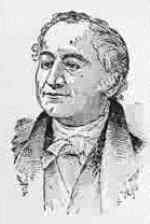John Rutherfurd
John Rutherfurd (September 20, 1760 – February 23, 1840) was an American politician and land surveyor. He represented New Jersey in the United States Senate from 1791 to 1798.[1]
John Rutherfurd | |
|---|---|
 | |
| United States senator from New Jersey | |
| In office March 4, 1791 – December 5, 1798 | |
| Preceded by | Jonathan Elmer |
| Succeeded by | Franklin Davenport |
| Member of the New Jersey General Assembly | |
| In office 1789–1790 | |
| Personal details | |
| Born | September 20, 1760 New York City, New York |
| Died | February 23, 1840 (aged 79) New Jersey |
| Political party | Federalist |
| Spouse(s) | Helena Morris
( m. 1782; |
| Relations | Lewis Morris (father-in-law) Lewis Morris Rutherfurd (grandson) |
| Children | 8 |
| Parents | Walter Rutherfurd Mary Alexander |
Early life
John Rutherfurd was born on September 20, 1760 in New York City to Walter Rutherfurd (1723–1804) and Catherine Alexander (1727–1801), daughter of James Alexander and Mary Spratt Provoost. His father Walter, a veteran of the British Army, was a hostage of the Patriots during the Revolutionary War while John was a teenager. Rutherfurd attended the College of New Jersey (now Princeton University) and studied law.[1]
His sister, Mary Rutherfurd, was married to Maj. Gen. Matthew Clarkson. His maternal uncle was William Alexander (1726–1783), also known as Lord Stirling. Rutherfurd was also related to Gilbert Elliot-Murray-Kynynmound, 4th Baronet (1751–1814), William Eden, 1st Baron Auckland (1745–1814), John Elliott (1732–1808), Governor of Newfoundland, Arthur St. Clair (1736–1818), a General and territorial Governor of Ohio.
Career
After graduating from the College of New Jersey, he practiced law in New York City for several years. In 1787, he moved to a farm near the village of Tranquility in Sussex County in New Jersey (after a boundary for a new county was drawn in 1824 his former holdings straddled Sussex and Warren Counties).
In 1788, he entered politics, serving in the New Jersey General Assembly until 1790. He was then elected as a Federalist to the United States Senate from New Jersey and served in the Senate from 1791 to 1798.[1]
Retirement from politics
After serving in the United States Senate, Rutherfurd then retired from politics, but continued to undertake several important projects during the rest of his life. He was one of the three Commissioners who laid out the plans for the Manhattan street grid north of 14th Street from 1807 to 1811. Around 1816 he investigated the building of a possible canal connecting the Delaware, Raritan and Hudson rivers. Finally, from 1827 to 1833, he helped settle New Jersey's boundaries with New York and Pennsylvania.
Personal life
In 1782, he married Helena Magdalena Morris (1762–1840), daughter of Congressman Lewis Morris, and remained married to her until his death in 1840, with Helena dying shortly after him. Together, they had eight children, including:[2]
- Mary Rutherfurd (1784–1868), who did not marry and served as the executor of her Rutherfurd's estate.[3]
- Robert Walter Rutherfurd (1788–1852), a member of the New Jersey State Legislature, who married Sabina Elliott Morris (1789–1857), his first cousin.[3]
- Helena Rutherfurd (1790–1873), who married Peter Gerard Stuyvesant (1778–1847), the 2x-great grandson of Peter Stuyvesant and one of the wealthiest New Yorkers in his lifetime.[4]
- Louisa Morris Rutherfurd (1792–1857), who died unmarried.[3]
- Anna Rutherfurd (1794–1852), who married Dr. John Watts (1786–1834), a son of Robert Watts (son of John Watts) and Mary (née Alexander) Watts (daughter of William Alexander, Lord Stirling).[5]
In 1808, Rutherfurd moved with his family to a farm on the banks of the Passaic River near what is now Rutherford, New Jersey. He lived at this place for the rest of his life, naming it "Edgerston", and died there.
Descendants
Rutherfurd's grandson through his son Robert, was Lewis Morris Rutherfurd (1816–1892), a pioneering astrophotographer who took the first telescopic photographs of the moon and sun, as well as many stars and planets.
Legacy
The town of Rutherford, New Jersey was named at least in part after John Rutherfurd, who had owned much of the land during his life. However, the spelling was changed due to the fame of President Rutherford B. Hayes who was President of the United States during the 1870s when the town was created.[6][7]
References
- "RUTHERFURD, John - Biographical Information". bioguide.congress.gov. Biographical Directory of the United States Congress. Retrieved 20 January 2017.
- The New York Genealogical and Biographical Record. New York Genealogical and Biographical Society. 1879. p. 64. Retrieved 1 October 2019.
- Fraser, Richard. "Guide to the Stuyvesant-Rutherfurd Papers 1647-1917 (bulk 1840-1917) MS 605". dlib.nyu.edu. New-York Historical Society. Retrieved 5 September 2019.
- "Funeral of Mrs. Stuyvesant". The New York Times. 21 August 1873. Retrieved 9 June 2018.
- Lamb, Martha; Lamb, Martha Joanna; Harrison, Burton (2005). History of the City of New York: Its Origin, Rise, and Progress-Vol. 3. Cosimo, Inc. p. 767. ISBN 9781596052857. Retrieved 1 October 2019.
- Hutchinson, Viola L. The Origin of New Jersey Place Names, New Jersey Public Library Commission, May 1945. Accessed September 27, 2015.
- Gannett, Henry. The Origin of Certain Place Names in the United States, p. 268. United States Government Printing Office, 1905. Accessed September 27, 2015.
External links
- United States Congress. "John Rutherfurd (id: R000550)". Biographical Directory of the United States Congress.
- John Rutherfurd at Find a Grave
| U.S. Senate | ||
|---|---|---|
| Preceded by Jonathan Elmer |
U.S. senator (Class 1) from New Jersey 1791–1798 Served alongside: Philemon Dickinson, Frederick Frelinghuysen, Richard Stockton |
Succeeded by Franklin Davenport |
| Honorary titles | ||
| Preceded by Paine Wingate |
Most Senior Living U.S. Senator (Sitting or Former) March 7, 1838 – February 23, 1840 |
Succeeded by Albert Gallatin |
